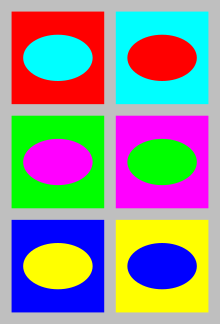Warna komplementer
Tampilan



Warna komplementer adalah sepasang warna yang, saat dipadukan, saling membatalkan satu sama lain. Ini menandakan bahwa saat dipadukan, mereka menghasilkan warna skala abu-abu seperti putih atau hitam.[1]
Referensi
[sunting | sunting sumber]- Isabelle Roelofs and Fabien Petillion, La couleur expliquée aux artistes, Editions Eyrolles, (2012), ISBN 978-2-212-13486-5.
- John Gage, Couleur et Culture, Usages et significations de la couleur de l'Antiquité à l'abstraction, (1993), Thames and Hudson ISBN 978-2-87811-295-5
- Philip Ball, Histoire vivante des couleurs (2001), Hazan Publishers, Paris, ISBN 978-2-754105-033
- Goethe, Theory of Colours, trans. Charles Lock Eastlake, Cambridge, MA: MIT Press, 1982. ISBN 0-262-57021-1
Catatan dan kutipan
[sunting | sunting sumber]Wikimedia Commons memiliki media mengenai Complementary colors.
- ^ Shorter Oxford English Dictionary, 5th Edition, Oxford University Press (2002) "A colour that combined with a given colour makes white or black."
